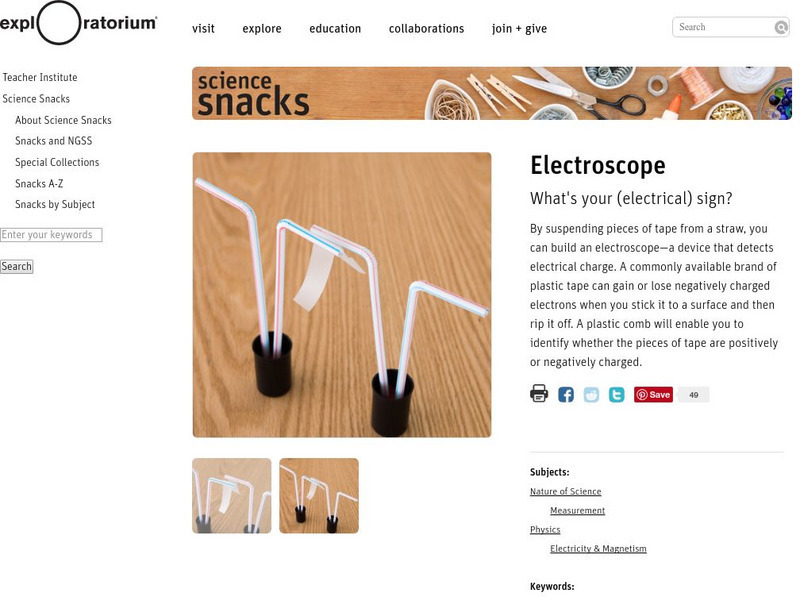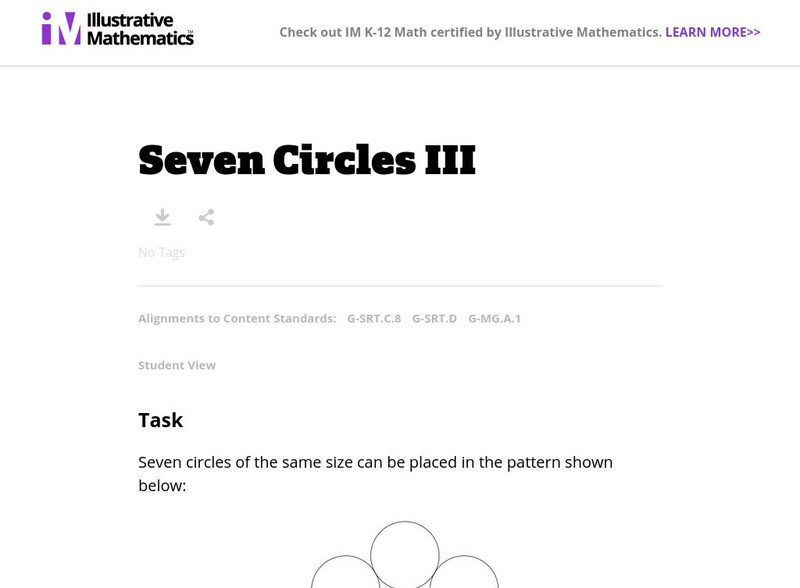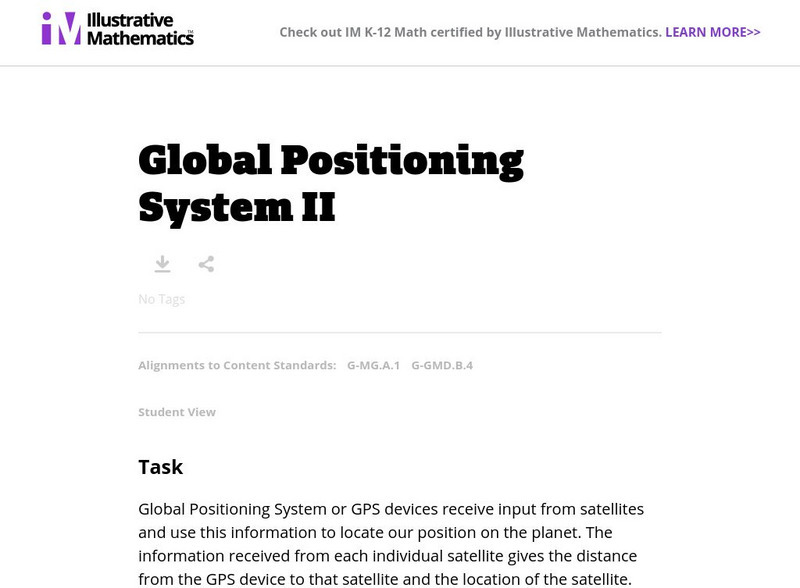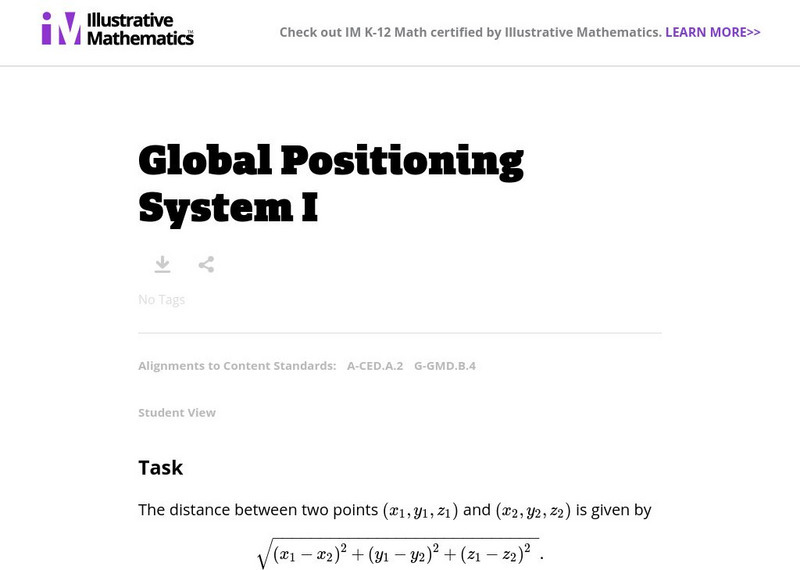Illustrative Mathematics
Illustrative Mathematics: 7.g Cube Ninjas!
In this lesson plan, 7th graders slice three dimensional objects to determine what two dimensional shape is created.
Illustrative Mathematics
Illustrative Mathematics: How Heavy
Students will have fun learning about weights with this hands-on activity. Students will use a balance scale to compare the weights of two different objects. Recording sheets are provided.
Illustrative Mathematics
Illustrative Mathematics: Roll & Build
The purpose of this task is to give students practice representing two-digit numbers with concrete objects to reinforce the meaning of the tens digit and the ones digit. Directions and materials needed are included in the lesson.
Other
Plan to Learn: Kinematics 1: Speedometer Cubed Lab (Physics)
Determine the speed of an object using three different methods and to compare the accuracy and precision of the results of each method.
Other
Conversions for Weight Measurements
This site allows you to convert weight/mass measurements. For example converting tons to grams. CCSS.Math.Content.3.MD.A.2 Measure and estimate liquid volumes and masses of objects using standard units
TeachEngineering
Teach Engineering: Pulley'ing Your Own Weight
Using common materials (spools, string, soap), students learn how a pulley can be used to easily change the direction of a force, making the moving of large objects easier. They see the difference between fixed and movable pulleys, and...
PBS
Pbs Learning Media: Circular Motion
In this interactive activity featuring videos adapted from the Rutgers PAER Group, students will observe examples of circular motion. Students will then find a common reason why the objects and people presented move in a circle. Includes...
Better Lesson
Better Lesson: Location
Common Core standards specify the requirement for children to use frequently occurring prepositions. Mastering this standard will help students formulate compound sentences as they go up in grade levels. In this lesson, students will use...
Library of Congress
Loc: Teachers: Personal Stories and Primary Sources
Students will explore the value of personal stories and first-hand accounts when exploring history, in this case, the events of the early twentieth century, which included World War I and the Great Depression. Through this five-unit...
Exploratorium
Exploratorium: Science Snacks: Electroscope
In this activity, students will build electroscopes from common materials. With their electroscopes, students can then conduct experiments to find out what happens to charged objects.
Illustrative Mathematics
Illustrative Mathematics: G Mg Hexagonal Pattern of Beehives
Beehives are made of walls, each of the same size, enclosing small hexagonal cells where honey and pollen are stored and bees are raised. This problem examines some of the mathematical advantages of the hexagonal tiling in a beehive....
Illustrative Mathematics
Illustrative Mathematics: G Mg Toilet Roll
Picture a roll of toilet paper; assume that the paper in the roll is very tightly rolled. Assuming that the paper in the roll is very thin, find a relationship between the thickness of the paper, the inner and outer radii of the roll,...
Illustrative Mathematics
Illustrative Mathematics: G Mg How Many Cells Are in the Human Body?
About how many cells are in the human body? The purpose of this task is for students to apply the concepts of mass, volume, and density in a real-world context. Aligns with G-MG.A.2.
Illustrative Mathematics
Illustrative Mathematics: G Srt, G Mg Seven Circles Iii
In this task, students are shown circle formations where an inner circle is surrounded by a set of circles and all circles are touching. In the first situation, all circles have the same diameter. In the second, the inner circle is...
Illustrative Mathematics
Illustrative Mathematics: G Mg, G Gmd Global Positioning System Ii
Satellites communicate with a GPS device and establish the distance between them and their locations. The set of points at a fixed distance from a satellite form a sphere so when the GPS receives its distance from a given satellite, this...
Illustrative Mathematics
Illustrative Mathematics: G Mg How Thick Is a Soda Can? Variation I
In this task, students are given the dimensions of a soda can and are asked to estimate its thickness. They must first find the surface area and the volume of aluminum. Aligns with G-MG.A.1 and G-MG.A.2.
Illustrative Mathematics
Illustrative Mathematics: G Mg Tilt of Earth's Axis and the Four Seasons
This task gives students a chance to explore the effects of the Earth's tilt and rotation using a simple geometric model of Earth-Sun interaction that shows why the seasons occur. Aligns with G-MG.A.1.
Illustrative Mathematics
Illustrative Mathematics: A Ced.2 and G Gmd.4: Global Positioning System I
This question examines the algebraic equations for three different spheres. The intersections of each pair of spheres are then studied, both using the equations and thinking about the geometry of the spheres. Aligns with A-CED.A.2 and...
National Council of Teachers of Mathematics
Nctm: Illuminations: Geometric Solids
An interactive game to find number of edges, surfaces and vertices of different geometric shapes.
University of Missouri
Museum of Anthropology: Minigalleries: Symbols of Tibetan Buddhism
Examples of ritual and spiritual objects common to the practice of Buddhism in Tibet, including the prayer wheel.
University of California
Cal Heritage Collection: Using Primary Sources
This resource covers what primary sources are, where we can find them, and how we can assess them in the classroom.
















